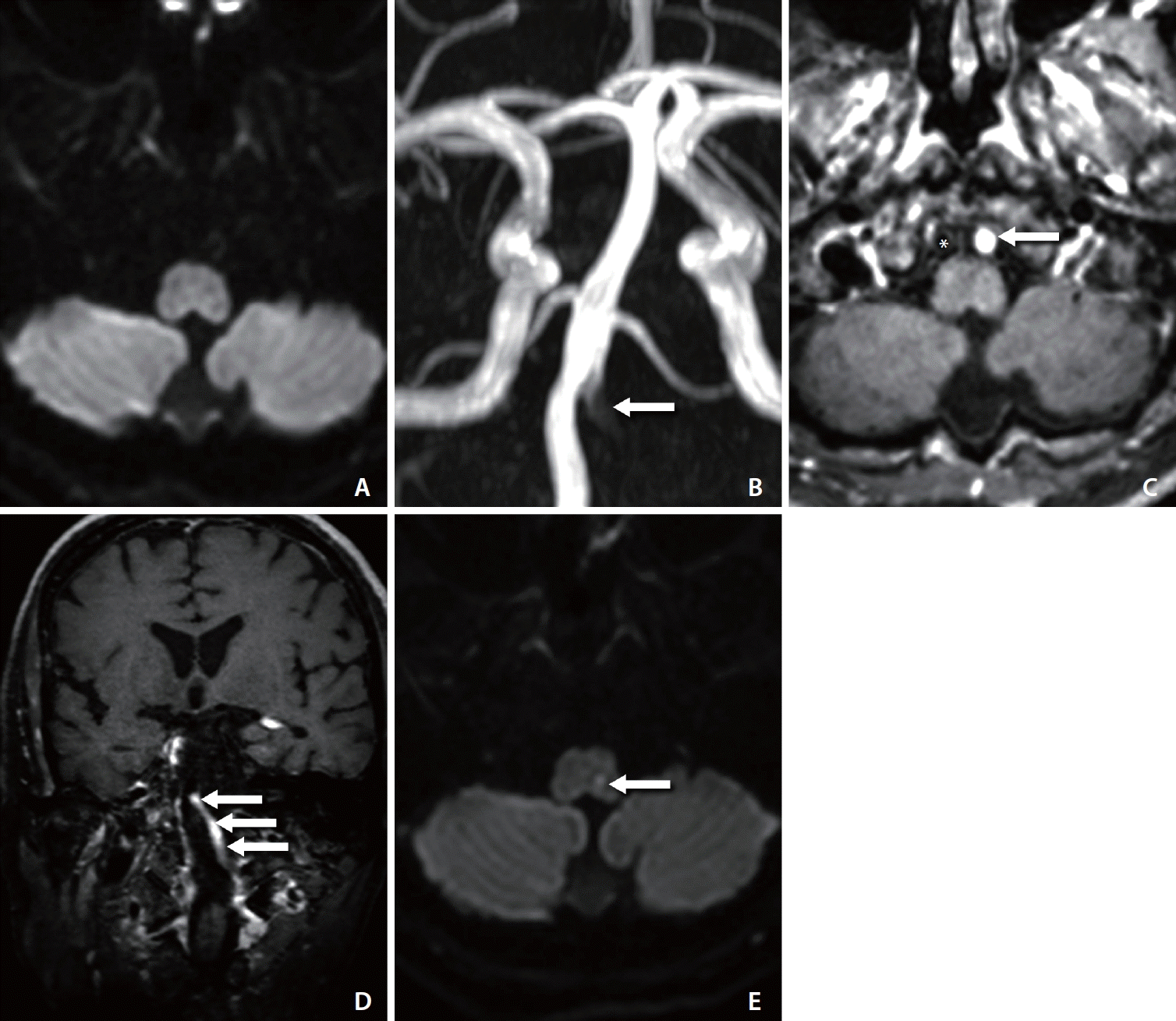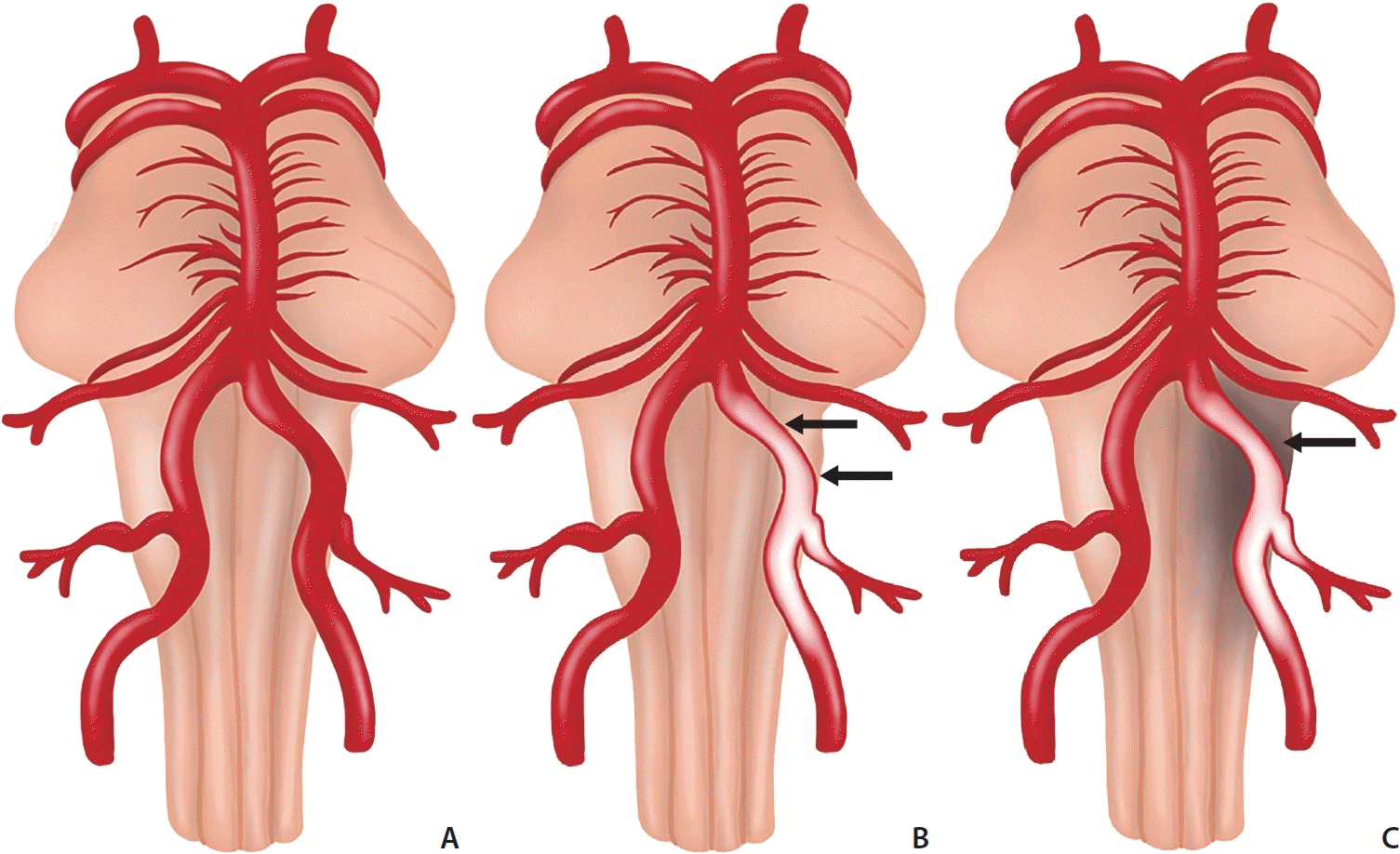1. Sparaco M, Ciolli L, Zini A. Posterior circulation ischaemic stroke-a review part I: anatomy, aetiology and clinical presentations. Neurol Sci. 2019; 40:1995–2006.

2. Ortiz de Mendivil A, Alcalá-Galiano A, Ochoa M, Salvador E, Millán JM. Brainstem stroke: anatomy, clinical and radiological findings. Semin Ultrasound CT MR. 2013; 34:131–141.

3. Kim K, Lee HS, Jung YH, Kim YD, Nam HS, Nam CM, et al. Mechanism of medullary infarction based on arterial territory involvement. J Clin Neurol. 2012; 8:116–122.

4. Chalela JA, Kidwell CS, Nentwich LM, Luby M, Butman JA, Demchuk AM, et al. Magnetic resonance imaging and computed tomography in emergency assessment of patients with suspected acute stroke: a prospective comparison. Lancet. 2007; 369:293–298.

5. Oppenheim C, Stanescu R, Dormont D, Crozier S, Marro B, Samson Y, et al. False-negative diffusion-weighted MR findings in acute ischemic stroke. AJNR Am J Neuroradiol. 2000; 21:1434–1440.
6. Al-Smadi AS, Abdalla RN, Elmokadem AH, Shaibani A, Hurley MC, Potts MB, et al. Diagnostic accuracy of high-resolution black-blood MRI in the evaluation of intracranial large-vessel arterial occlusions. AJNR Am J Neuroradiol. 2019; 40:954–959.

7. Fayad ZA, Fuster V, Fallon JT, Jayasundera T, Worthley SG, Helft G, et al. Noninvasive in vivo human coronary artery lumen and wall imaging using black-blood magnetic resonance imaging. Circulation. 2000; 102:506–510.

8. Jang W, Kwak HS, Chung GH, Hwang SB. Three-dimensional black-blood contrast-enhanced MRI improves detection of intraluminal thrombi in patients with acute ischaemic stroke. Eur Radiol. 2018; 28:3840–3847.

9. Yang H, Zhu Y, Geng Z, Li C, Zhou L, Liu QI. Clinical value of black-blood high-resolution magnetic resonance imaging for intracranial atherosclerotic plaques. Exp Ther Med. 2015; 10:231–236.

10. Baik SH, Kwak HS, Hwang SB, Chung GH. Three-dimensional black blood contrast enhanced magnetic resonance imaging in patients with acute ischemic stroke and negative susceptibility vessel sign. Eur J Radiol. 2018; 102:188–194.

11. Chung GH, Hwang SB, Kwak HS. Use of 3-dimensional, blackblood, contrast-enhanced, T1-weighted magnetic resonance imaging to identify vascular occlusion in the posterior circulation after acute ischemic stroke. J Stroke Cerebrovasc Dis. 2019; 28:104373.

12. Wang J, Gerretsen SC, Maki JH, Jaarsma C, Kooi ME, Herzka D, et al. Time-efficient black blood RCA wall imaging at 3T using improved motion sensitized driven equilibrium (iMSDE): feasibility and reproducibility. PLoS One. 2011; 6:e26567.

13. Wang J, Yarnykh VL, Yuan C. Enhanced image quality in blackblood MRI using the improved motion-sensitized driven-equilibrium (iMSDE) sequence. J Magn Reson Imaging. 2010; 31:1256–1263.

14. Head T, Daunert S, Goldschmidt-Clermont PJ. The aging risk and atherosclerosis: a fresh look at arterial homeostasis. Front Genet. 2017; 8:216.

15. Gang M, Lee H, Kwak HS, Hwang SB, Chung GH. Strong enhancement on three-dimensional black-blood enhanced magnetic resonance imaging: comparison intracranial stenosis and complete occlusion. Eur J Radiol. 2021; 137:109580.

16. Lee KY, Suh SH, Ahn SJ. Significance of hyperintense arteries on Gd-enhanced 3D T1W black-blood imaging in acute stroke. Eur Radiol. 2019; 29:1329–1337.

17. Mercier PH, Brassier G, Fournier HD, Picquet J, Papon X, Lasjaunias P. Vascular microanatomy of the pontomedullary junction, posterior inferior cerebellar arteries, and the lateral spinal arteries. Interv Neuroradiol. 2008; 14:49–58.

18. Kim JS, Lee JH, Choi CG. Patterns of lateral medullary infarction: vascular lesion-magnetic resonance imaging correlation of 34 cases. Stroke. 1998; 29:645–652.
19. Bhin J, Kwak HS, Hwang SB, Chung GH. Comparison of imaging findings on three-dimensional black-blood enhanced MR imaging between intracranial atherosclerotic occlusion and thrombotic occlusion. J Stroke Cerebrovasc Dis. 2023; 32:106877.

20. Lövblad KO, Laubach HJ, Baird AE, Curtin F, Schlaug G, Edelman RR, et al. Clinical experience with diffusion-weighted MR in patients with acute stroke. AJNR Am J Neuroradiol. 1998; 19:1061–1066.








 PDF
PDF Citation
Citation Print
Print



 XML Download
XML Download